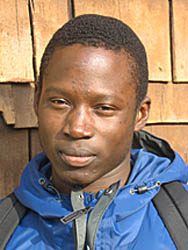A meeting of cultures around a Creole Table

It feels like Mom’s kitchen, but with a few more people around. The bustling, warm atmosphere and the smell of cooking make the small kitchen homey and relaxing. Lively music can barely be heard over the animated chatter.
After wandering around for several minutes, I have made my way into the kitchen. I’m attempting to dice red peppers and thinking that I probably should have spent less time with the takeout menu and more quality time in the kitchen with my mother learning how not to slice off a finger.
It’s Friday afternoon, Oct. 3, and this is my first visit to Bates’Multicultural Center. The occasion is one of the center’s Creole Tables — dinner gatherings whose presentations explore the variety of multiracial, multiethnic cultures called Creole. Staff, students and faculty get together to make dinner and discuss a particular nation and its Creole culture, building bridges between different groups within the college.
Tonight, Shervin Chambers ’12 of Brooklyn, N.Y., will talk about St. Lucia, an island in the eastern Caribbean where he lived until 2005. Past Creole Table speakers have included Myrna Manzanares, president of the National Kriol Council of Belize, and Juan Tomás Ávila Laurel, an essayist, novelist and poet from Equatorial Guinea.

“Creole” means different things to different nations. In the United States, Creole culture is central in Louisiana, where Creole refers to people descended fromFrench settlers (but not Acadian French, who are called Cajuns). These people share a rich cultural background and live in Francophone communities.
In the Caribbean, Creole refers to the fusion among African, European and native cultures, and the term is applied to all people born and raised in the region.
Crossing distinctions between generations and between faculty, students and staff, tonight’s group includes Charles Nero, associate professor of rhetoric; Tonya Taylor ’02, program coordinator for the Multicultural Affairs office; Baltasar Fra-Molinero, associate professor of Spanish; and Theodore Sutherland, a sophomore from Ghana.
The menu is usually chosen by the evening’s presenter. Tonight, the sweet red peppers I’m chopping are for the green figs and saltfish, St. Lucia’s national dish. Saltfish is dried salted fish, normally cod.
The saltfish is boiled to remove some salt, chopped fine, sautéed with chives, garlic, tomatoes and other seasonings, and then served with boiled green bananas. As soon as it’s ready and on the table, I can’t help sneaking a bite of the flavorful dish.
We’ve also made chicken and dumplings, and sweet and savory slices of fried green plantains that allay our hunger until the rest of the food is ready. As we eat, Chambers gives us a presentation on St. Lucia, complete with a tourist video and an explanation of the island’s flag, displayed boldly in the kitchen.
Questions range from St. Lucia’s economy to the origin of the island’s name (a Christian martyr of Roman times), to island race relations to, ultimately, where and how quickly we can buy plane tickets to relax on those sandy beaches. Chambers tells us he can’t wait to move back.
As we eat (I go back for seconds), he plays a video of traditional St. Lucian dancing, and we view slideshow images of the island — including a food stall where the main dish is exactly the one we’re putting in our mouths, green figs and saltfish.
“Food brings people together,” Chambers says. “And preparing the food, cooking the food, you learn a lot of what goes into it, and just from doing that, you know so much about the culture.”
— Becca Chacko ’10